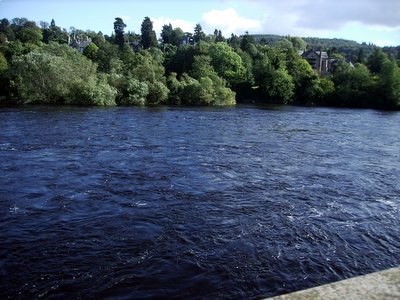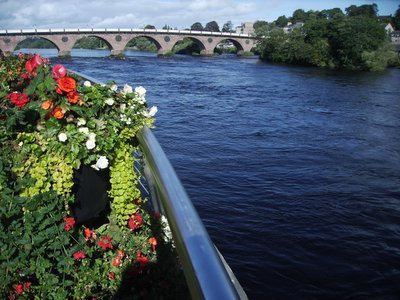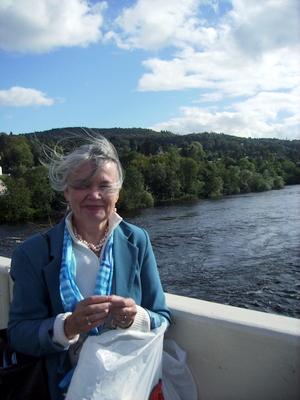River Tay Perth, Scotland
Historic Info & Photos
River Tay and Scottish Pearls

River Tay Perth - Photo by Kari
Today, it is illegal to gather pearls from the Tay River and other Scottish Rivers. This historical information from 1908 is for research purposes, it is not meant as an enticement to search for pearls in the Tay....please remember this is not allowed anymore.
Seeing this very fast flowing river was great fun. It runs through the city of Perth, Scotland, which is the home of the famous Abernethy Pearl.
Before the Perth Smeaton bridge was build in the 1771 (still very much in use), folks had to be ferried across, but the current is so strong (one reason for such great pearls coming from this river) that several ferrymen died. There is a monument to their bravery on the Perth shoreline.

River Tay - Photo by Kari
For several years following 1760, the Scotch pearl fisheries were of considerable local value. The zoologist, Thomas Pennant, wrote of them several times in his "Tour of Scotland." Referring ot the Tay and Isla rivers, as the center of the Scotch pearling, he states: "There has been in these parts a very great fishery of pearl, got out of the fresh-water mussels. From the year 1761 to 1764, £10,000 worth were sent to London, and sold from 10s to £1 6s per ounce I was told that a pearl had been taken there that weighed 33 grains. But this fishery was exhausted, from the avarice of the undertakers. It once extended as far as Loch Tay."
And he adds later that, some pearls preceding, a pearl fishery was prosecuted in Loch Dochart with great success and the pearls were esteemed the fairest and largest of any.
From 1770 to 1860 the pearl resources of Scotland remained almost dormant, and Scotch pearls were rarely met within the markets. In 1861 a German merchant, who was acquainted with the beauty of these gems, traveled through the districts of Tay, Doon and Don, obtaining a great number which the poor people kept for their own pleasure, not esteeming them of any market value, and interested the fishermen in searching for the mussels.
The seemingly high prices which he paid and the abundance of the pearls sent hundreds of persons to the rivers and small brooks. Those who were otherwise employed during the day devoted hours of the long summer nights to diligent search after the coveted shells; while boys and old persons, who were without regular avocations, waded day after day where there was a probability of reward.
In the course of a short time pearls, good, bad and indifferent, reached the originator of the movement in Edinburgh, form Ayrshire, from Perthshire, and from the Highland regions far beyond the Grampians. He was soon the possessor of a collection which, for richness and variety, had seldom been surpassed.
A trade in these gems was developed, the patronage of royalty was obtained, and once more Scotch pearls became fashionable, and their vogue was enhanced by the fondness which Queen Victoria entertained for them.
The pearl mussel of the British Isles (Unio margaritifera) has a thick, coarse and unsightly shell, from 3 to 7 inches in width and 1 1/2 to 1 1/2 inches in length from he unbo to the lip. The rough exterior is dark brown, and it is sometimes twisted, distorted and barnacled.
The River Tay produces many pearls, yet as a rule they are not of the best class. Some of its tributaries, as the Tummel and the Isla, also bear pearls; those in the Isla are usually fine and rank higher than those from the River Tay.
Mr. D. MacGregor, a former well-known jeweler of Perth, to whom we are indebted for much information relative to pearls in Scotland, states: "No attention whatever is given to conserving the mussel: on the contrary, the waters are unscrupulously despoiled by the greedy pearl fisherman who destroys all that he finds, since, by chance, they may yield the coveted gem. Immense numbers are thus wantonly destroyed, which if allowed to grow and propagate would be more likely to contribute to the pearl yield, as it is well known that it is the aged mussels in which a pearl is most likely to be found. There is no close time, and so extensive have been the raids upon the mussels in recent years (at beginning of twentieth century) that they have been rapidly exterminated in place accessible to the fishermen; and should the spoliation continue and extend to the deep waters, the pearl-mussel may soon become extinct."
Perth City is a bustling market town with a great deal to offer visitors looking for a self catering holiday in Scotland. Shops, galleries, theaters, restaurants and beautiful historic walks are all close at hand.
The Perth area of Scotland is the perfect center for a break, touring holiday or golf expedition. (Did you know that golf was invented in Scotland?) The silvery Tay which flows through Perth is the perfect setting for walks, picnics or time away, just to think.
Perth now has a very attractive River frontage.This developed over many centuries ago.Originally a wooden bridge, which was lost and swept away in a storm. The loss of a safe crossing in 1621 contributed to a decline in the town's fortunes, and in 1766 Thomas, Earl of Kinnoull headed an effort to obtain funding for a new bridge. Financial backing from the government and the Earl himself, as well as public subscription led to the commission of John Smeaton, architect of the Eddystone Lighthouse, to build a new bridge at Perth. Smeaton's bridge was completed in 1771 and is generally known as Perth Bridge.

Kari on River Tay Bridge at Perth Scotland
In February 1774, during a rapid thaw, broken ice became wedged under the bridge, and blocked up the river channel. Most of the town and both Inches were flooded, but the bridge stood firm. Smeaton's bridge has survived many floods since. Some of the flood levels are marked on the north side of the west most pier. Increasing traffic during the 19th century resulted in the bridge being widened by A. D. Stewart in 1869. The stone parapets were removed, and footpaths projected over iron brackets.
The source of the River Tay, the longest river in Scotland, is on Ben Lui, near Tyndrum in Perthshire, Scotland. It runs for more than 119 miles into the North Sea, past Dunkeld, and beyond Dundee. The River Tay is one of the most important Scottish salmon rivers.
Special thanks to Kunz and Stevenson for their 1908 account of the River Tay.
The River Tay also flows into the enchanting Kingdom of Fife. You won't want to miss this fascinating part of Scotland just a few miles from Perth.
Enjoy this page? Please pay it forward. Here's how...
Would you prefer to share this page with others by linking to it?
- Click on the HTML link code below.
- Copy and paste it, adding a note of your own, into your blog, a Web page, forums, a blog comment, your Facebook account, or anywhere that someone would find this page valuable.